
 Meade Anderson "Lux" Lewis (September 4[?], 1905 - June 7, 1964) | |
 Compositions Compositions | |
|
1927
Honky Tonk Train BluesYancey Special 1940
Six Wheel ChaserBass on Top Tell Your Story Rising Tide Blues 1944
Chicago FlyerBlues Whistle Meade's Blues c.1940s
Glendale GlideDoll House Boogie Denapa's Parade Boogie Tidal Celeste Blues Randini's Boogie Yancey's Pride |
c.1940s (Cont)
Lux's BoogieMedium Blues Whistlin' Blues Slow Boogie Medium Boogie Fast Boogie Fast and Blues Two and Fews Bear Cat Crawl Unknown or Uncertain
Number 1 BoogieRockin' the Clock Closing Hour Blues Jumpin' for Pete Deep Fives Albert's Blues Far Ago Blues Rising Tide Blues Meade's Boogie |
 Selected Discography Selected Discography | |
|
1927
Honky Tonk Train Blues1930
Molasses Sopper Blues [1]Alley Rat Blues [1] I Got Some of That [2] The Preacher Must Get Some Sometime [2] Don't Put That Thing [2] 1931
I Don't want It Now [2]1936
Honky Tonk Train BluesYancey Special Celeste Blues I'm In the Mood for Love Mr. Freddie Blues 1937
Honky Tonk Train BluesWhistlin' Blues 1938
Honky Tonk TrainHonky Tonk Train Whistling Blues Boogie Woogie Prayer Parts 1 & 2 [3,4] Bear Cat Crawl 1939
MelancholySolitude The Blues (Parts 1-4) Messin' Around Deep Fives Blues De Lux After Hour Blues [5] Blues for Tommy [6] Basin Street Blues [6] Pounding Heart Blues [6] Twos and Fews [3] Café Society Rag [3,4] 1940
Honky Tonk Train BluesBass on Top Six Wheel Chaser Tell Your Story Tell Your Story No. 2 1941
Rising Tide BluesNineteen Ways of Playing a Chorus School of Rhythm Self Portrait Feeling Tomorrow Like I Feel Today 1944
Doll House BoogieDenapa's Parade Boogie Tidal Randini's Boogie Lux's Boogie Yancey's Pride Glendale Glide Chicago Flyer Blues Whistle 1946
Medium BoogieFast Boogie Slow Boogie Honky Tonk Train 1952
Meade Lux Lewis Interpretations1954
Meade Lux Lewis At the Piano (EP)1955
Down Home (LP)1956
Yancey's Last Ride (LP)1957
Barrel House Piano (LP)1961
The Blues Piano Artistry ofMeade Lux Lewis (LP) 1957
Boogie Woogie House Party (LP)
1. w/George Hannah: vcl
2. w/Bob Robinson: vcl 3. w/Albert Ammons |
Matrix and Recording/Release Date
[Paramount 20246] 12/??/1927[Paramount L0563] 10/??/1930 [Paramount L0608] 11/??/1930 [Paramount L0609] 11/??/1930 [Paramount L0610] 11/??/1930 [Decca 90561] 01/11/1936 [Decca 90562] 01/11/1936 [Decca 90563] 01/11/1936 [Decca 90564] 01/11/1936 [Victor 06302] 03/07/1937 [LoC 2496-A] 12/24/1938 [LoC 2496-B] 12/24/1938 [Vocalion 23890-1/2] 12/30/1938 [Vocalion 23893] 12/30/1938 [Blue Note 444] 01/06/1939 [Blue Note 486-A1-A4] 01/06/1939 [Solo Art R2087] 02/??/1939 [Solo Art R2088] 02/??/1939 [Solo Art R2089] 02/??/1939 [Blue Note GM532] 05/06/1939 [Blue Note GM532] 05/06/1939 [Blue Note GM534] 05/06/1939 [Blue Note GM536] 05/06/1939 [Blue Note GM537] 05/06/1939 [Vocalion 25026] 06/30/1939 [Blue Note RS792] 10/04/1940 [Blue Note RS793] 10/04/1940 [Blue Note RS794-A] 10/04/1940 [Blue Note RS794-B] 10/04/1940 [Blue Note RS934] 04/09/1941 [Blue Note RS935] 04/09/1941 [Blue Note RS937] 04/09/1941 [Blue Note RS938] 04/09/1941 [Asch 728] 08/18/1944 [Asch 729] 08/18/1944 [Asch 730] 08/18/1944 [Asch 731] 08/18/1944 [Asch 732] 08/18/1944 [Asch 746] 08/18/1944 [Blue Note 1202] 08/22/1944 [ 1203] 08/22/1944 [Disc 267] ??/??/1946 [Disc 268] ??/??/1946 [Disc 269] ??/??/1946
4. w/Pete Johnson
5. w/Franke Newton Quintet 6. w/Port of Harlem 7 |
The son of Kentucky natives George Anderson Lewis and Hattie Johnson, Meade Lewis grew up in the hotbed of hot jazz and dynamic piano playing, Chicago, Illinois. While reportedly born in Chicago, which he stated on most documents from the 1920s forward, his obituary noted that he might have been born in Louisville, Kentucky, his father's native town. It was difficult to find the family in the 1910 enumeration, making this possibility more challenging to pin down. There are also questions as to his actual date of birth. In addition to September 4th, both September 3rd and 13th have been cited in some places. He was too young for a World War I draft record, and none could be located for World War II, both usually accurate sources. However, given that his Social Security death record showed September 4th, 1905, this is the most likely candidate.
Meade was the oldest of five boys, including Joseph (1908), George (1911), Lee (1913) and Julius (1919). The family had settled in south Chicago. George Lewis, who had been a Pullman Coach porter for many years, started employment with the postal system in the 1910s. For the 1920 enumeration, Meade was shown working as a door boy for a shoe store, and as no longer attending school. He acquired the nickname "Lux" because as a child he liked to imitate the excessively polite comic strip characters Alphonse and Gaston, right down to stroking his non-existent beard, and his friends ended up calling himself the "Duke of Luxembourg." Among his friends was another future boogie woogie pianist, Albert Ammons, and Meade spent many days at the Ammons household plugging away at their upright piano.
Despite his desire to play piano, difficult in a home where none was found, Meade's father, who was also a working guitarist, insisted that he take up the more refined and dignified violin. However, George Lewis died in 1921 when Meade was 16, and the lad went right back into the piano. He would never return to the fiddle. Lewis and Ammons had yet another pianistic friend named Toy, according so some sources, and it was at Toy's piano in 1923 that he worked out his signature piece, the as yet unnamed Honky Tonk Train Blues, although it would not be committed to disc for another four years.
In his early twenties, Lewis hung out more often with Ammons, both of whom had become taxi drivers by trade for the Silver Taxicab Company. There is an account (hard to confirm) that the owner, who had several musicians in his employ, installed a piano in the lounge at the shop to give the drivers incentive to return back to the shop with regularity.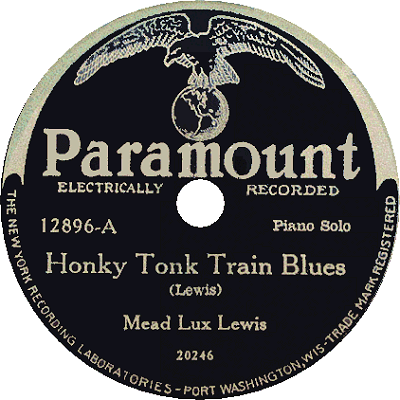 Albert and Meade drove by day, then played for rent parties at night. They soon shared an apartment together, as Lewis moved in with Meade and his young bride Lila Sherrod. While Meade and Albert were first developing their piano style, it was not yet quite boogie woogie, but more barrelhouse ragtime. However, around 1923 to 1924 they either heard a recording of The Rocks as played by its composer, George Washington Thomas of Alabama, or more likely a performance of The Fives by the same composer, played by somebody in Chicago. Either way, it spurred them on to learn and further develop the rolling boogie woogie left-hand style that would become their individual signatures.
Albert and Meade drove by day, then played for rent parties at night. They soon shared an apartment together, as Lewis moved in with Meade and his young bride Lila Sherrod. While Meade and Albert were first developing their piano style, it was not yet quite boogie woogie, but more barrelhouse ragtime. However, around 1923 to 1924 they either heard a recording of The Rocks as played by its composer, George Washington Thomas of Alabama, or more likely a performance of The Fives by the same composer, played by somebody in Chicago. Either way, it spurred them on to learn and further develop the rolling boogie woogie left-hand style that would become their individual signatures.
 Albert and Meade drove by day, then played for rent parties at night. They soon shared an apartment together, as Lewis moved in with Meade and his young bride Lila Sherrod. While Meade and Albert were first developing their piano style, it was not yet quite boogie woogie, but more barrelhouse ragtime. However, around 1923 to 1924 they either heard a recording of The Rocks as played by its composer, George Washington Thomas of Alabama, or more likely a performance of The Fives by the same composer, played by somebody in Chicago. Either way, it spurred them on to learn and further develop the rolling boogie woogie left-hand style that would become their individual signatures.
Albert and Meade drove by day, then played for rent parties at night. They soon shared an apartment together, as Lewis moved in with Meade and his young bride Lila Sherrod. While Meade and Albert were first developing their piano style, it was not yet quite boogie woogie, but more barrelhouse ragtime. However, around 1923 to 1924 they either heard a recording of The Rocks as played by its composer, George Washington Thomas of Alabama, or more likely a performance of The Fives by the same composer, played by somebody in Chicago. Either way, it spurred them on to learn and further develop the rolling boogie woogie left-hand style that would become their individual signatures.While they continued to ply their passions at night, Ammons managed to find work for Lewis with a band in Chicago, but Albert was unable to hold the job long. Although he was skilled at repeating melodies he heard, he was limited at that time to playing mostly in the keys of C and G, rather than the flatted key signatures largely favored by jazz bands. Meade did manage to get steady work playing for parties in Detroit in 1926, where he and Ammons had moved by that time, given a slightly less ambitious but still well-established black musical community. These gatherings came with a certain risk since alcohol was usually present, despite national prohibition. Whenever a police raid occurred, Meade and Albert learned how to quickly get out on a balcony or ledge, wait for the police to leave with a few suspects, then take some of the brew for themselves. Within a year or so the boys had relocated to South Bend, Indiana, where Ammons was hired by the Paradise Inn. Lewis managed to get a job playing piano in a brothel, and possibly managing it as well. Within a few months, however, they would return home to Chicago. Around that time in 1927, due either to his wandering lifestyle or perhaps some philandering, Albert was either separated or divorced from Lila, who remained with her parents into the 1940s.
The building the pair moved into was coincidentally where yet another developing boogie woogie pianist, Clarence "Pine Top" Smith, resided with his wife. By late 1927 (possibly early 1928), Smith had relocated to the Windy City from Pittsburgh by way of the Theatre Owners Booking Association (TOBA) which included extensive tours of the South and Texas. (There are sources claiming they had been together much earlier, but Smith's time line negates that possibility.)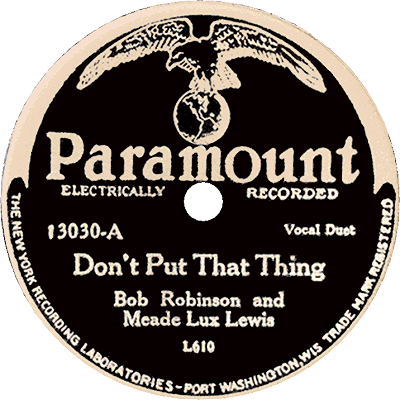 The trio became inseparable pianistic sparring partners, sharing ideas and jamming together at parties. It is likely that Pine Top exerted some influence on Ammons and Lewis, showing them some of the Texas style of barrelhouse, and they probably returned the favor showing him their own licks. In fact, Lewis' Honky Tonk Train Blues is close in structure and sound to Smith's Pine Top's Boogie-Woogie, although the nature of the cross-influence is difficult to pinpoint with any certainty. Given that Lewis had recorded his piece around the time or perhaps even before he met Smith, he probably set the template. One more influence was Chicago pianist and eventual mentor Jimmy Yancey, who left an indelible imprint on Meade, Albert, and the ill-fated Smith, as well as a long friendship, perhaps kinship.
The trio became inseparable pianistic sparring partners, sharing ideas and jamming together at parties. It is likely that Pine Top exerted some influence on Ammons and Lewis, showing them some of the Texas style of barrelhouse, and they probably returned the favor showing him their own licks. In fact, Lewis' Honky Tonk Train Blues is close in structure and sound to Smith's Pine Top's Boogie-Woogie, although the nature of the cross-influence is difficult to pinpoint with any certainty. Given that Lewis had recorded his piece around the time or perhaps even before he met Smith, he probably set the template. One more influence was Chicago pianist and eventual mentor Jimmy Yancey, who left an indelible imprint on Meade, Albert, and the ill-fated Smith, as well as a long friendship, perhaps kinship.
 The trio became inseparable pianistic sparring partners, sharing ideas and jamming together at parties. It is likely that Pine Top exerted some influence on Ammons and Lewis, showing them some of the Texas style of barrelhouse, and they probably returned the favor showing him their own licks. In fact, Lewis' Honky Tonk Train Blues is close in structure and sound to Smith's Pine Top's Boogie-Woogie, although the nature of the cross-influence is difficult to pinpoint with any certainty. Given that Lewis had recorded his piece around the time or perhaps even before he met Smith, he probably set the template. One more influence was Chicago pianist and eventual mentor Jimmy Yancey, who left an indelible imprint on Meade, Albert, and the ill-fated Smith, as well as a long friendship, perhaps kinship.
The trio became inseparable pianistic sparring partners, sharing ideas and jamming together at parties. It is likely that Pine Top exerted some influence on Ammons and Lewis, showing them some of the Texas style of barrelhouse, and they probably returned the favor showing him their own licks. In fact, Lewis' Honky Tonk Train Blues is close in structure and sound to Smith's Pine Top's Boogie-Woogie, although the nature of the cross-influence is difficult to pinpoint with any certainty. Given that Lewis had recorded his piece around the time or perhaps even before he met Smith, he probably set the template. One more influence was Chicago pianist and eventual mentor Jimmy Yancey, who left an indelible imprint on Meade, Albert, and the ill-fated Smith, as well as a long friendship, perhaps kinship.In 1927, Meade became acquainted with a girl who worked for a publishing company, and she managed to get him a recording date. His first important recording of Honky Tonk Train Blues was initially cut in December of 1927 on Paramount Records of Port Washington, Wisconsin, although it was recorded in Chicago. While the chances are fair that he had already named it, there is a story that he was calling it Freight Train, to which the recording engineer told him it sounded more like honky-tonk music. Since that term was still not widely used, this tale can be taken with a shaker of salt just in case. Despite, or perhaps because of its revolutionary sound, the company did not release it until 1929. Although Meade and Albert's primary style of the mid-1920's is considered boogie, which is the boogie rhythm with a non-moving bass line, Lewis and his companions soon developed their own individual styles of boogie-woogie,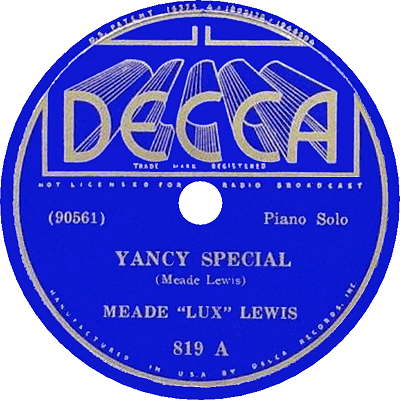 the hard-driving "eight to the bar" blues that had originated in the deep South, particularly New Orleans, and concurrently in Texas and Alabama. The players had added a moving bass line to the boogie pattern, often with s in the left hand. The early recordings of Lewis and his peers, including Yancey and Charles "Cow Cow" Davenport, helped to establish boogie-woogie as a major blues piano style in the late l920's and into 1930. But it was still considered to be black music, and was therefore relegated to "race" labels like Paramount, Vocalion, Gennett and OKeh.
the hard-driving "eight to the bar" blues that had originated in the deep South, particularly New Orleans, and concurrently in Texas and Alabama. The players had added a moving bass line to the boogie pattern, often with s in the left hand. The early recordings of Lewis and his peers, including Yancey and Charles "Cow Cow" Davenport, helped to establish boogie-woogie as a major blues piano style in the late l920's and into 1930. But it was still considered to be black music, and was therefore relegated to "race" labels like Paramount, Vocalion, Gennett and OKeh.
 the hard-driving "eight to the bar" blues that had originated in the deep South, particularly New Orleans, and concurrently in Texas and Alabama. The players had added a moving bass line to the boogie pattern, often with s in the left hand. The early recordings of Lewis and his peers, including Yancey and Charles "Cow Cow" Davenport, helped to establish boogie-woogie as a major blues piano style in the late l920's and into 1930. But it was still considered to be black music, and was therefore relegated to "race" labels like Paramount, Vocalion, Gennett and OKeh.
the hard-driving "eight to the bar" blues that had originated in the deep South, particularly New Orleans, and concurrently in Texas and Alabama. The players had added a moving bass line to the boogie pattern, often with s in the left hand. The early recordings of Lewis and his peers, including Yancey and Charles "Cow Cow" Davenport, helped to establish boogie-woogie as a major blues piano style in the late l920's and into 1930. But it was still considered to be black music, and was therefore relegated to "race" labels like Paramount, Vocalion, Gennett and OKeh.In December of 1928, a year after Meade's recording, and then in January of 1929, Pine Top would record eight sides for the Vocalion label, a recently acquired subsidiary of Columbia Records, which released them even before Meade's initial effort. However, Smith was accidently killed at the age of 25 that March, creating a void in the Chicago blues piano community. With Smith's demise and the onset of the world-wide Great Depression in 1930, interest in boogie woogie music started to fade as people turned to swing music and movie musicals for entertainment. Lewis was again working at non-playing jobs to help supplement what little he made from performing. He occasionally managed to find work as a studio musician. Among those gigs was a series of songs recorded at Paramount with singers Bob Robinson and George Hannah. These tracks, some with mildly salacious or suggestive titles and topics, including homosexuality, were essentially performed in a blues piano style, and Meade handles them very deftly, even providing additional vocals along with Robinson. They also demonstrate that he had expanded his knowledge of key signatures. After one last side cut in 1931, he all but disappeared from public view in Chicago.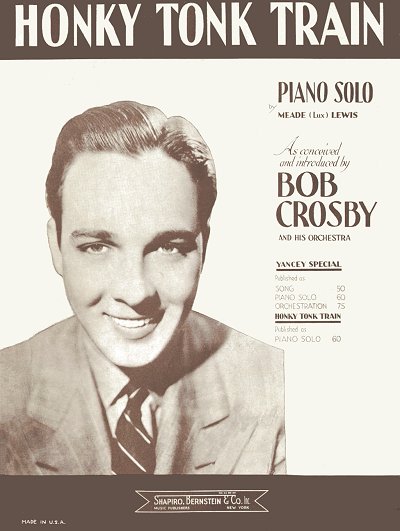 He was also not found in the 1930 Federal census, further compounding the difficulty in tracing his whereabouts at that time.
He was also not found in the 1930 Federal census, further compounding the difficulty in tracing his whereabouts at that time.
 He was also not found in the 1930 Federal census, further compounding the difficulty in tracing his whereabouts at that time.
He was also not found in the 1930 Federal census, further compounding the difficulty in tracing his whereabouts at that time.The boogie woogie style was kept more or less localized to the locations where Lewis, Ammons, Yancey and George Thomas played, so was rarely heard in much of the country. Lewis played for the occasional rent party, and found sporadic piano work at Chicago clubs, and even reportedly a Muskegon, Michigan brothel. However, these were all short-term gigs which mostly dried up as the Depression deepened. Often living on relief and eating at soup kitchens, when the New Deal came along in 1933, he managed to get some work with the Works Progress Administration (WPA) doing manual labor. By 1934 he was back in Chicago, and Ammons got him a job working as a private driver. The following year he formed a trio of piano, horn and drums called Lux and His Chips, but was also working at a car wash to maintain a steady income. Thanks to the interest of jazz promoter John Hammond of Columbia Records, who had been listening to the scant roster of recordings made by Meade and his compatriots since the early 1930x, Lewis was located after a concerted two-year search. It was partially coincidental, according to a 1939 syndicated article by George Ross. As Hammond, visiting Chicago in late 1935, was talking with Ammons and another musician, one of them remarked, "Too bad about Meade Lux, ain't it?", to which the promoter jumped up and asked, "Do you mean Meade Lux Lewis, the pianist?" "Sure, that's him. Too bad, ain't it? He's washin' cars in one of them South Side garages." Ammons immediately took John to the location where they found him "drearily at work" at the car wash.
With Hammond's help, both Meade and Albert were back in front of the public as performers within weeks. He managed to get them both sessions at Decca Records in early 1936, with Lewis cutting newer and better-recorded renditions of Honky Tonk Train Blues, Yancey Special, and a few others, including a boogie woogie recorded on a celeste. His first major appearance was at a Chicago concert noted in the Chicago Tribune of December 18 and December 20, 1936, taking the stage with singer Mildred Bailey and the dance orchestra of Red Norvo. Similar appearances slowly increased from that time forward, including a session at Victor Records, giving Meade and his music national exposure. He tried briefly to gain a foothold in Manhattan in 1937, but soon returned to his familiar environs in Chicago.
Even though he was now performing recording again, Lewis continued working at the car wash and other day jobs as a matter of security until Hammond prevailed and finally pulled him out of that life back into the musical limelight.
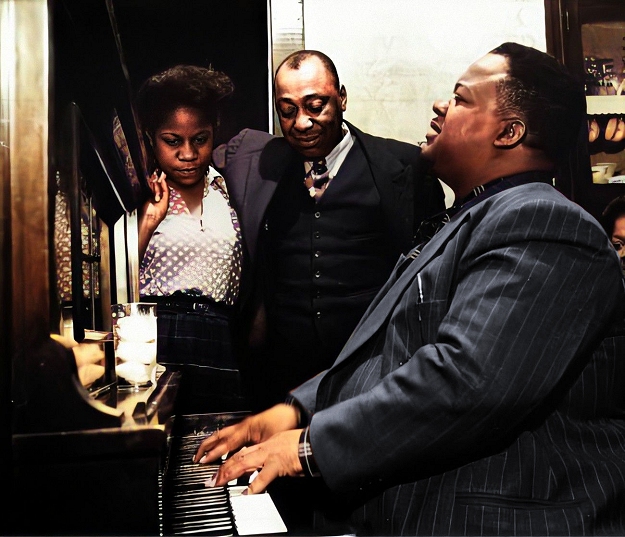 |
Bob Crosby, younger brother of singer Bing Crosby, was making waves with his own swing orchestra, with its dynamic but self-destructive pianist Bob Zurke. Possibly through Zurke, Bob started to incorporate boogie woogie tunes into his orchestra's lineup, eventually recording both Yancey Special, then Honky Tonk Train Blues, with Zurke at the piano. This seemed to ignite a new interest in boogie woogie among a wider listening audience. It also spurred the publishing house of Shapiro-Bernstein to get permission to publish the Lewis works, providing him extra exposure and income. Throughout 1938, more articles were appearing in music periodicals and other media concerning boogie woogie. The timing was suddenly right to unleash this music to the world.
So it was that Lewis and Ammons and another Hammond find, Kansas City, Missouri, pianist Pete Johnson followed Benny Goodman's historic 1938 swing concert at Carnegie Hall with an appearance of their own arranged by Hammond on December 23, 1938, From Spirituals to Swing. Almost immediately after their historic appearance in the storied venue, playing six-handed boogie woogie on two pianos to vocals by Joe Turner, a whole new fascination with the genre exploded into the world and cultivated the boogie woogie craze of the early 1940s. Shortly after the concert, Alan Lomax, who had recently completed the now-famous cycle of recordings by Ferdinand "Jelly Roll" Morton on his life and music, interviewed the trio of Ammons, Lewis and Johnson for the Library of Congress, along with some recordings of their playing. All three of them were further tapped for new records, including the double-sided Boogie Woogie Prayer released on the OKeh and Vocalion labels (and later on Columbia). Separately, Johnson, Ammons and Lewis were also the first artists to record tracks for the newly minted Solo Art label.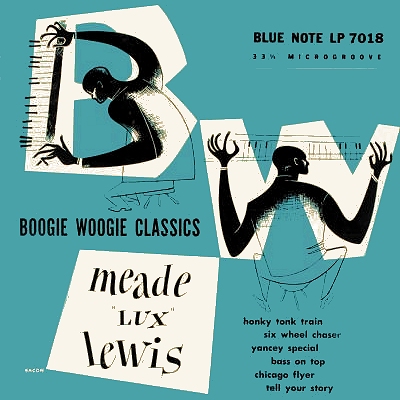 For Blue Note, a label formed by European enthusiast and performer Alfred Lion on the heels of that Carnegie Hall appearance, Lewis laid down a set of refined harpsichord renditions of his blues style in 1941 in what should be considered a suite of lovely tunes.
For Blue Note, a label formed by European enthusiast and performer Alfred Lion on the heels of that Carnegie Hall appearance, Lewis laid down a set of refined harpsichord renditions of his blues style in 1941 in what should be considered a suite of lovely tunes.
 For Blue Note, a label formed by European enthusiast and performer Alfred Lion on the heels of that Carnegie Hall appearance, Lewis laid down a set of refined harpsichord renditions of his blues style in 1941 in what should be considered a suite of lovely tunes.
For Blue Note, a label formed by European enthusiast and performer Alfred Lion on the heels of that Carnegie Hall appearance, Lewis laid down a set of refined harpsichord renditions of his blues style in 1941 in what should be considered a suite of lovely tunes.The three pianists soon found themselves featured at the Café Society, a Greenwich Village nightclub in lower Manhattan, working as the Boogie Woogie Trio, sometimes billed as the Boogie Woogie Boys when Turner was singing. They collectively ended up playing there regularly for at least two years, and their playing was occasionally broadcast on the air from the club. They would occasionally take time off from New York to play at the Sherman Hotel in Chicago. In both cities they were joined by prominent jazz musicians of the day, both black and white. He and his cohorts were also featured on a number of radio broadcasts from Chicago, including shortwave shows on CBS intended for the United Kingdom. The 1940 enumeration taken in Manhattan showed Meade listed as a theater musician, although that may have been a catch-all since he appears to have mostly worked in night spots. Finally tiring of the relentless sharing of the spotlight with the trio, and possibly recognizing that boogie woogie was once again on the wane, Meade left the group in 1941. They may have also broken up due to a serious injury to one of Ammons' hands from a kitchen knife.
Meade moved to Los Angeles and spent the remainder of his life based there doing occasional recording sessions and club gigs in both California and Illinois.
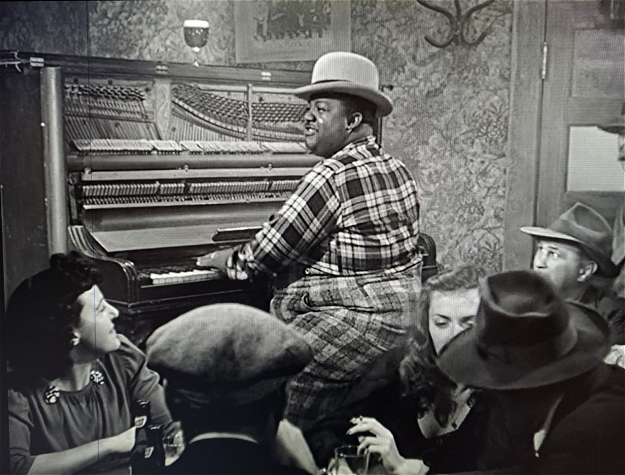 |
In 1942 Lewis was admitted to ASCAP shortly after his colleague Cow Cow Davenport, a rarity at that time for black musicians in their line, but something that, in theory, would provide them with some protection of their works and income derived from performances of them. He also made four "soundies," short performance films that serve as prototypes for music videos commonly seen decades later, and sometimes available in specialized jukeboxes around the country. Meade soon found his own niche playing contemporary standards and jazz in Hollywood at Randini's Club in 1944 or so, for which he dedicated a boogie on a set of recordings on the Asch label (re-released by Stinson in 1962). Boogie at the Philharmonic was comprised of a set of four works recorded on the short-lived Disc label in 1946. While residing in Los Angeles Lewis found the opportunity to appear in some short films and a few features, including as a pianist in It's a Wonderful Life in the alternate 1946 scene in Nick's bar, New Orleans (1947), with no less than Louis Armstrong, and Nightmare (1956) with Edward G. Robinson. He even made some local television appearances at a time when the new medium was starving for live entertainment of any kind in lieu of regular scripted programming. A handful of listings for him were located for stations like KTLA during 1950 and 1951.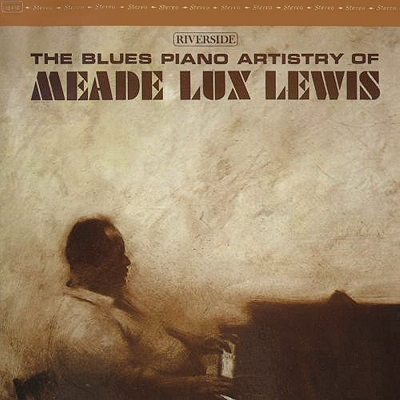 The 1950 enumeration, taken in Los Angeles, showed that Lewis was living alone and working as a cocktail lounge pianist. Meade was also involved in the successful Piano Parade tour of 1952 with his friend Pete Johnson, and stride pianists Erroll Garner and Art Tatum.
The 1950 enumeration, taken in Los Angeles, showed that Lewis was living alone and working as a cocktail lounge pianist. Meade was also involved in the successful Piano Parade tour of 1952 with his friend Pete Johnson, and stride pianists Erroll Garner and Art Tatum.
 The 1950 enumeration, taken in Los Angeles, showed that Lewis was living alone and working as a cocktail lounge pianist. Meade was also involved in the successful Piano Parade tour of 1952 with his friend Pete Johnson, and stride pianists Erroll Garner and Art Tatum.
The 1950 enumeration, taken in Los Angeles, showed that Lewis was living alone and working as a cocktail lounge pianist. Meade was also involved in the successful Piano Parade tour of 1952 with his friend Pete Johnson, and stride pianists Erroll Garner and Art Tatum.Meade's weight of 290-plus pounds became a serious issue near the end of his life, forcing him to give up alcohol and restrict his diet just to maintain his health. Lewis continued to perform his signature piece, although at increasingly faster tempos, live and on recordings to the end of his life. By the late 1950s jobs were very infrequent, and he often would drive halfway across the country for an engagement of a week or more. Sadly, he was killed while away from his West Coast home after an evening performance at the end of a three-week engagement in Minneapolis, Minnesota, at the White House Restaurant in Golden Valley. On his way back to his lodging, Meade's car was struck from the rear at 80 miles per hour by Ronald Bates, pinning Lewis between his vehicle and a tree and killing him instantly at age 58. A passenger in Bates' car also perished the next morning. Although Lewis was still living in Los Angeles at 629 East 116th Street, the pianist had been pondering a move back to the Midwest (he had a niece in Minneapolis), where he sadly met his demise. His music still lives on with us, however, through countless performances either of his work or influenced by his driving dynamic style.
A great deal of information for this essay was collected from public records, newspapers, periodicals, copyright records and recording company histories. Some of the gaps were filled in by a fine article compiled by Bob Hall in the Blues Encyclopedia (2004) edited by Edwar Komara and Peter Lee, highly recommended for the library of anybody interested in this music. Virtually all of his recordings can be found on YouTube.